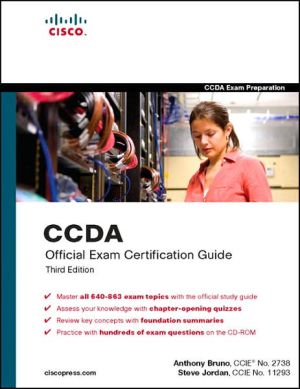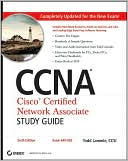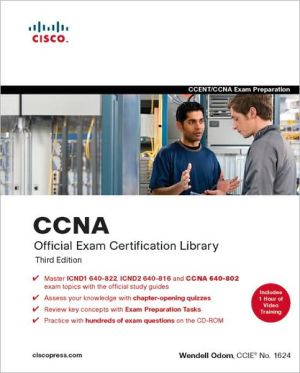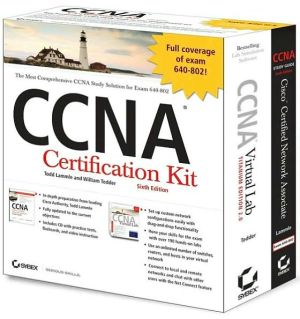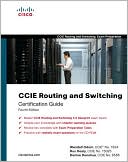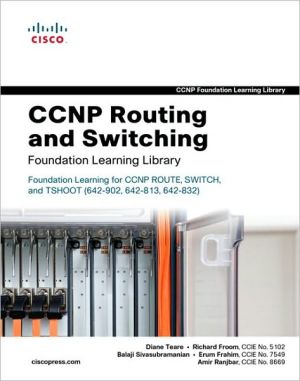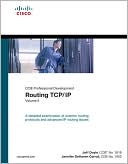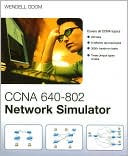CCDA Official Exam Certification Guide
CCDA Official Exam Certification Guide\ Third Edition\ \ Master all 640-863 exam topics with the official study guide\ Assess your knowledge with chapter-opening quizzes\ Review key concepts with foundation summaries\ Practice with hundreds of exam questions on the CD-ROM\ \ Anthony Bruno, CCIE® No. 2738\ Steve Jordan, CCIE No. 11293\ CCDA Official Exam Certification Guide, Third Edition, is a best-of-breed Cisco® exam study guide that focuses specifically on the topics for the DESGN exam....
Search in google:
CCDA Official Exam Certification GuideThird Edition Master all 640-863 exam topics with the official study guide Assess your knowledge with chapter-opening quizzes Review key concepts with foundation summaries Practice with hundreds of exam questions on the CD-ROMAnthony Bruno, CCIE® No. 2738Steve Jordan, CCIE No. 11293CCDA Official Exam Certification Guide, Third Edition, is a best-of-breed Cisco® exam study guide that focuses specifically on the topics for the DESGN exam. Senior networking consultants Anthony Bruno and Steve Jordan expertly cover the latest exam content, helping you identify areas of weakness and improve your knowledge of Cisco network design. Material is presented in a concise manner, focusing on increasing your understanding and retention of exam topics.CCDA Official Exam Certification Guide presents you with an organized test preparation routine through the use of proven series elements and techniques. “Do I Know This Already?” quizzes open each chapter and allow you to decide how much time you need to spend on each section. Exam topic lists and concise Foundation Summary information make referencing easy and give you a quick refresher whenever you need it. Challenging chapter-ending review questions help you assess your knowledge and reinforce key concepts.The companion CD-ROM contains a powerful testing engine that allows you to focus on individual topic areas or take complete, timed exams. The assessment engine also tracks your performance and provides feedback on a topic-by-topic basis, presenting question-by-question remediation to the text.Well regarded for its level of detail, assessment features, and challenging review questions and exercises, this book helps you master the concepts and techniques that will enable you to succeed on the exam the first time.CCDA Official Exam Certification Guide, Third Edition, is part of a recommended learning path from Cisco that includes simulation and hands-on training from authorized Cisco Learning Partners and self-study products from Cisco Press. To find out more about instructor-led training, e-learning, and hands-on instruction offered by authorized Cisco Learning Partners worldwide, please visit www.cisco.com/go/authorizedtraining.A. Anthony Bruno, CCIE® No. 2738, is a senior principal consultant with British Telecom with more than 17 years experience in the internetworking field. He has consulted for many enterprise and service-provider customers in the design, implementation, and optimization of large-scale data and IP telephony networks.Steve Jordan, CCIE No. 11293, is a senior consultant with British Telecom with more than 11 years of experience in internetworking. He has extensive experience with large-scale data-center environments and has designed and implemented various network solutions in the manufacturing, telecommunication, and transportation industries.This official study guide helps you master all the topics on the DESGN exam, including Network design methodology Network structure models Enterprise LAN design Wireless LAN design Enterprise edge module design WAN design IPv4 and IPv6 Routing protocol selection RIP, EIGRP, OSPF, and IS-IS BGP, route manipulation, and IP multicast Security management, technologies, and design Voice architectures and IP telephony design Network management protocolsCompanion CD-ROMThe CD-ROM contains an electronic copy of the book and more than 200 practice questions for the DESGN exam, all available in study mode, test mode, and flash card format.This volume is part of the Exam Certification Guide Series from Cisco Press®. Books in this series provide officially developed exam preparation materials that offer assessment, review, and practice to help Cisco Career Certification candidates identify weaknesses, concentrate their study efforts, and enhance their confidence as exam day nears.Category: Cisco Press—Cisco CertificationCovers: CCDA® DESGN exam 640-863
ForewordIntroductionPart I General Network DesignChapter 1 Network Design Methodology"Do I Know This Already?" QuizFoundation TopicsIntelligent Information Network and Service-Oriented Network ArchitectureIIN FrameworkSONANetwork Infrastructure LayerInteractive Service LayerApplication LayerBenefits of SONAPrepare, Plan, Design, Implement, Operate, and Optimize PhasesPrepare PhasePlan PhaseDesign PhaseImplement PhaseOperate PhaseOptimize PhaseDesign Methodology Under PPDIOOIdentifying Customer RequirementsCharacterizing the Existing NetworkSteps in Gathering InformationNetwork Audit ToolsNetwork Analysis ToolsNetwork ChecklistDesigning the Network Topology and SolutionsTop-Down ApproachPilot and Prototype TestsDesign DocumentReferences and Recommended ReadingFoundation SummaryQ&AChapter 2 Network Structure Models"Do I Know This Already?" QuizFoundation TopicsHierarchical Network ModelsBenefits of the Hierarchical ModelHierarchical Network DesignCore LayerDistribution LayerAccess LayerHierarchical Model ExamplesCisco Enterprise Architecture ModelEnterprise Campus ModuleEnterprise Edge ModuleE-CommerceInternet EdgeVPN/Remote AccessEnterprise WANService Provider (SP) Edge ModuleRemote ModulesEnterprise Branch ModuleEnterprise Data Center ModuleEnterprise Teleworker ModuleNetwork AvailabilityWorkstation-to-Router RedundancyARPExplicit ConfigurationRDPRIPHSRPGLBPServer RedundancyRoute RedundancyLoad BalancingIncreasing AvailabilityMedia RedundancyReferences and Recommended ReadingFoundation SummaryQ&APart II LAN and WAN DesignChapter 3 Enterprise LAN Design"Do I Know This Already?" QuizFoundation TopicsLAN MediaEthernet Design Rules10-Mbps Fiber Ethernet Design Rules100-Mbps Fast Ethernet Design RulesGigabit Ethernet Design Rules1000BASE-LX Long-Wavelength Gigabit Ethernet1000BASE-SX Short-Wavelength Gigabit Ethernet1000BASE-CX Gigabit Ethernet over Coaxial Cable1000BASE-T Gigabit Ethernet over UTP10 Gigabit Ethernet (10GE) Design Rules10GE Media TypesFast EtherChannelToken Ring Design RulesLAN HardwareRepeatersHubsBridgesSwitchesRoutersLayer 3 SwitchesLAN Design Types and ModelsBest Practices for Hierarchical LayersAccess Layer Best PracticesDistribution Layer Best PracticesCore Layer Best PracticesLarge-Building LANsEnterprise Campus LANsEdge DistributionMedium Site LANsSmall and Remote Site LANsServer-Farm ModuleServer Connectivity OptionsEnterprise Data Center InfrastructureCampus LAN Quality of Service ConsiderationsMulticast Traffic ConsiderationsCGMPIGMP SnoopingReferences and Recommended ReadingsFoundation SummaryQ&AChapter 4 Wireless LAN Design"Do I Know This Already?" QuizFoundation TopicsWireless LAN TechnologiesWireless LAN StandardsISM and UNII FrequenciesSummary of Wireless LAN StandardsService Set Identifier (SSID)WLAN Layer 2 Access MethodWLAN SecurityUnauthorized AccessWLAN Security Design ApproachIEEE 802.1X-2001 Port-Based AuthenticationDynamic WEP Keys and LEAPControlling WLAN Access to ServersCisco Unified Wireless NetworkCisco UWN ArchitectureLWAPPLWAPP Access Point ModesLWAPP DiscoveryWLAN AuthenticationAuthentication OptionsWLAN Controller ComponentsWLC Interface TypesAP Controller Equipment ScalingRoaming and Mobility GroupsIntracontroller RoamingLayer 2 Intercontroller RoamingLayer 3 Intercontroller RoamingMobility GroupsWireless LAN DesignController Redundancy DesignN+1 WLC RedundancyN+N WLC RedundancyN+N+1 WLC RedundancyRadio Management and Radio GroupsRadio Frequency (RF) GroupsRF Site SurveyUsing EoIP Tunnels for Guest ServicesWireless Mesh for Outdoor WirelessMesh Design RecommendationsCampus Design ConsiderationsBranch Design ConsiderationsLocal MACREAPHybrid REAPBranch Office Controller OptionsReferences and Recommended ReadingsFoundation SummaryQ&AChapter 5 WAN Technologies"Do I Know This Already?" QuizFoundation TopicsWAN Technology OverviewWAN DefinedWAN Connection ModulesWAN ComparisonDialupISDNFrame RelayTime-Division MultiplexingSONET/SDHMultiprotocol Label SwitchingOther WAN TechnologiesDigital Subscriber LineCableWirelessDark FiberDense Wave Division MultiplexingOrdering WAN Technology and ContractsWAN Design MethodologyResponse TimeThroughputReliabilityBandwidth ConsiderationsWindow SizeData CompressionOptimizing Bandwidth Using QoSQueuing, Traffic Shaping, and PolicingPriority QueuingCustom QueuingWeighted Fair QueuingClass-Based Weighted Fair QueuingLow-Latency QueuingTraffic Shaping and PolicingReferences and Recommended ReadingsFoundation SummaryQ&AChapter 6 WAN Design"Do I Know This Already?" QuizFoundation TopicsTraditional WAN TechnologiesWAN TopologiesHub-and-Spoke TopologyFull-Mesh TopologyPartial-Mesh TopologyRemote-Access Network DesignVPN Network DesignOverlay VPNsVirtual Private Dialup NetworksPeer-to-Peer VPNsVPN BenefitsWAN Backup DesignLoad-Balancing GuidelinesWAN Backup over the InternetLayer 3 TunnelingEnterprise WAN ArchitectureCisco Enterprise MAN/WANEnterprise WAN/MAN Architecture ComparisonEnterprise Edge ComponentsHardware SelectionSoftware SelectionCisco IOS PackagingComparing Hardware and SoftwareEnterprise Branch ArchitectureBranch DesignEnterprise Branch ProfilesSingle-Tier DesignDual-Tier DesignMulti-Tier DesignEnterprise Teleworker (Branch of One) DesignReferences and Recommended ReadingsFoundation SummaryQ&APart III The Internet Protocol and Routing ProtocolsChapter 7 Internet Protocol Version 4"Do I Know This Already?" QuizFoundation TopicsIPv4 HeaderToSIPv4 FragmentationIPv4 AddressingIPv4 Address ClassesClass A AddressesClass B AddressesClass C AddressesClass D AddressesClass E AddressesIPv4 Private AddressesNATIPv4 Address SubnetsMask NomenclatureIP Address Subnet Design ExampleDetermining the Network Portion of an IP AddressVLSMsVLSM Address-Assignment ExampleLoopback AddressesIP Telephony NetworksCIDR and SummarizationAddress Assignment and Name ResolutionStatic and Dynamic IP Address AssignmentBOOTPDHCPDNSARPReferences and Recommended ReadingsFoundation SummaryQ&AChapter 8 Internet Protocol Version 6"Do I Know This Already?" QuizFoundation TopicsIntroduction to IPv0IPv6 HeaderIPv6 Address RepresentationIPv4-Compatible IPv6 AddressesIPv6 Prefix RepresentationIPv6 Address Types and Address AllocationsIPv6 Unicast AddressIPv6 Anycast AddressIPv6 Multicast AddressIPv6 Address AllocationsUnspecified AddressLoopback AddressIPv4-Compatible IPv6 AddressGlobal Unicast AddressesLink-Local AddressesSite-Local AddressesMulticast AddressesIPv6 MechanismsICMPv0IPv6 Network Discovery (ND) ProtocolIPv6 Name ResolutionPath MTU DiscoveryIPv6 Address-Assignment StrategiesAutoconfiguration of Link-Local AddressDHCPv6IPv6 SecurityIPv6 Routing ProtocolsRIPng for IPv6EIGRP for IPv6OSPFv3 for IPv6IS-IS for IPv6BGP4 Multiprotocol Extensions for IPv6IPv4 to IPv6 Transition Strategies and DeploymentsIPv6 over Dedicated WAN LinksIPv6 over IPv4 TunnelsDual-Stack BackbonesDual-Stack HostsProtocol Translation MechanismsIPv6 Comparison with IPv4References and Recommended ReadingsFoundation SummaryQ&AChapter 9 Routing Protocol Selection Criteria"Do I Know This Already?" QuizFoundation TopicsRouting Protocol CharacteristicsStatic Versus Dynamic Route AssignmentInterior Versus Exterior Routing ProtocolsDistance-Vector Routing ProtocolsEIGRPLink-State Routing ProtocolsDistance-Vector Routing Protocols Versus Link-State ProtocolsHierarchical Versus Flat Routing ProtocolsClassless Versus Classful Routing ProtocolsIPv4 Versus IPv6 Routing ProtocolsAdministrative DistanceRouting Protocol Metrics and Loop PreventionHop CountBandwidthCostLoadDelayReliabilityMaximum Transmission Unit (MTU)Routing Loop-Prevention SchemesSplit HorizonSplit Horizon with Poison ReverseCounting to InfinityTriggered UpdatesSummarizationODRReferences and Recommended ReadingsFoundation SummaryQ&AChapter 10 RIP and EIGRP Characteristics and Design"Do I Know This Already?" QuizFoundation TopicsRIPv1RIPv1 Forwarding Information BaseRIPv1 Message FormatRIPv1 TimersUpdate TimerInvalid TimerFlush TimerHolddown TimerRIPv1 DesignRIPv1 SummaryRIPv2AuthenticationMD5 AuthenticationRIPv2 Forwarding Information BaseRIPv2 Message FormatRIPv2 TimersRIPv2 DesignRIPv2 SummaryRIPngRIPng TimersAuthenticationRIPng Message FormatRIPng DesignRIPng SummaryIGRPIGRP TimersIGRP MetricsIGRP DesignIGRP SummaryEIGRP for IPv4 NetworksEIGRP ComponentsProtocol-Dependent ModulesNeighbor Discovery and RecoveryRTPDUALEIGRP TimersEIGRP MetricsEIGRP Packet TypesEIGRP DesignEIGRP SummaryEIGRP for IPv6 NetworksEIGRP for IPv6 DesignEIGRP for IPv6 SummaryReferences and Recommended ReadingsFoundation SummaryRIPv1 SummaryRIPv2 SummaryRIPng SummaryEIGRP for IPv4 SummaryEIGRP for IPv6 SummaryQ&AChapter 11 OSPF and IS-IS"Do I Know This Already?" QuizFoundation TopicsOSPFv2OSPFv2 Concepts and DesignOSPFv2 MetricOSPFv2 Adjacencies and Hello TimersOSPFv2 AreasOSPF Router TypesOSPF DRsLSA TypesOSPF Stub Area TypesVirtual LinksOSPFv2 Router AuthenticationOSPFv2 SummaryOSPFv3OSPFv3 Changes from OSPFv2OSPFv3 Areas and Router TypesOSPFv3 Link State AdvertisementsOSPFv3 SummaryIS-ISIS-IS MetricsIS-IS Operation and DesignNETIS-IS DRsIS-IS AreasIS-IS AuthenticationIS-IS for IPv6IS-IS SummaryReferences and Recommended ReadingsFoundation SummaryOSPFv2 SummaryOSPFv3 SummaryIS-IS SummaryQ&AChapter 12 Border Gateway Protocol, Route Manipulation, and IP Multicast"Do I Know This Already?" QuizFoundation TopicsBGPBGP NeighborseBGPiBGPRoute ReflectorsConfederationsBGP Administrative DistanceBGP Attributes, Weight, and the BGP Decision ProcessBGP Path AttributesNext-Hop AttributeLocal Preference AttributeOrigin AttributeAS Path AttributeMED AttributeCommunity AttributeAtomic Aggregate and Aggregator AttributesWeightBGP Decision ProcessBGP SummaryRoute ManipulationPBRRoute SummarizationRoute RedistributionDefault MetricOSPF RedistributionIP Multicast ReviewMulticast AddressesLayer 3 to Layer 2 MappingIGMPIGMPv1IGMPv2IGMPv3CGMPIGMP SnoopingSparse Versus Dense Multicast Routing ProtocolsMulticast Source and Shared TreesPIMPIM-SMPIM DRAuto-RPPIMv2 Bootstrap RouterDVMRPIPv6 Multicast AddressesReferences and Recommended ReadingsFoundation SummaryBGP SummaryRoute RedistributionIP MulticastQ&APart IV Security, Convergence, and Network ManagementChapter 13 Security Management"Do I Know This Already?" QuizFoundation TopicsNetwork Security OverviewSecurity LegislationSecurity ThreatsReconnaissance and Port ScanningVulnerability ScannersUnauthorized AccessSecurity RisksTargetsLoss of AvailabilityIntegrity Violations and Confidentiality BreachesSecurity Policy and ProcessSecurity Policy DefinedBasic Approach of a Security PolicyPurpose of Security PoliciesSecurity Policy ComponentsRisk AssessmentContinuous SecurityIntegrating Security Mechanisms into Network DesignTrust and Identity ManagementTrustDomains of TrustIdentityPasswordsTokensCertificatesAccess ControlSecure ConnectivityEncryption FundamentalsEncryption KeysVPN ProtocolsTransmission ConfidentialityData IntegrityThreat DefensePhysical SecurityInfrastructure ProtectionReferences and Recommended ReadingsFoundation SummaryQ&AChapter 14 Security Technologies and Design"Do I Know This Already?" QuizFoundation TopicsCisco Self-Defending NetworkNetwork Security PlatformsSelf-Defending Network PhasesTrust and Identity TechnologiesFirewall ACLsNAC Framework and ApplianceCisco Identity-Based Network ServicesIdentity and Access Control DeploymentsDetecting and Mitigating ThreatsThreat Detection and Mitigation TechnologiesThreat Detection and Mitigation SolutionsSecurity Management ApplicationsSecurity Platform SolutionsIntegrating Security into Network DevicesIOS SecurityISR Security Hardware OptionsCisco Security AppliancesIntrusion PreventionCatalyst 6500 Services ModulesEndpoint SecuritySecuring the EnterpriseImplementing Security in the CampusImplementing Security in the Data CenterImplementing Security in the Enterprise Edge and WANReferences and Recommended ReadingsFoundation SummaryQ&AChapter 15 Traditional Voice Architectures and IP Telephony Design"Do I Know This Already?" QuizFoundation TopicsTraditional Voice ArchitecturesPBX and PSTN SwitchesLocal Loop and TrunksPortsMajor Analog and Digital Signaling TypesLoop-Start SignalingGround-Start SignalingE&M SignalingCAS and CCS SignalingPSTN Numbering PlanOther PSTN ServicesCentrex ServicesVoice MailDatabase ServicesIVRACDVoice TerminologyGrade of ServiceErlangsCentum Call Second (CCS)Busy HourBusy Hour Traffic (BHT)Blocking ProbabilityCall Detail RecordsIntegrated Multiservice NetworksVoFRVoATMVoIPIPT ComponentsDesign Goals of IP TelephonyIPT Deployment ModelsSingle-Site DeploymentMultisite Centralized WAN Call-Processing ModelMultisite Distributed WAN Call-Processing ModelUnified CallManager Express DeploymentsCodecsAnalog-to-Digital Signal ConversionCodec StandardsVoIP Control and Transport ProtocolsDHCP, DNS, and TFTPSSCPRTP and RTCPMGCPH.323SIPIPT DesignBandwidthVADDelay ComponentsQoS Mechanisms for VoIP NetworksCRTPLFIPQ-WFQLLQAuto QoSIPT Design RecommendationsReferences and Recommended ReadingsFoundation SummaryQ&AChapter 16 Network Management Protocols"Do I Know This Already?" QuizFoundation TopicsSNMPSNMP ComponentsMIBSNMP Message TypesSNMPv1SNMPv2SNMPv3Other Network Management TechnologiesRMONRMON2NetFlowNetFlow Compared to RMONCDPSyslogReferences and Recommended ReadingFoundation SummaryQ&APart V Comprehensive ScenariosChapter 17 Comprehensive ScenariosScenario One: Pearland HospitalScenario One QuestionsScenario One AnswersScenario Two: Big Oil and GasScenario Two QuestionsScenario Two AnswersScenario Three: Beauty Things StoreScenario Three QuestionsScenario Three AnswersScenario Four: Falcon CommunicationsScenario Four QuestionsScenario Four AnswersPart VI AppendixesAppendix A Answers to Chapter "Do I Know This Already?" Quizzes and Q&A SectionsAppendix B The OSI Reference Model, TCP/IP Architecture, and Numeric Conversion1587201771 TOC 5/9/2007
